Natural language names
 | Bekleidung / Belag |
 | Covering |
 | Revêtement |
Change log
| Item | SPF | XML | Change | Description | IFC2x3 to IFC4 4.0.0.0 |
|---|---|---|---|---|
| IfcCovering | MOVED | Schema changed from IFCPRODUCTEXTENSION to IFCSHAREDBLDGELEMENTS. | ||
| OwnerHistory | MODIFIED | Instantiation changed to OPTIONAL. | IFC4x2 Candidate 4.2.0.0 | |
| IfcCovering | ||||
| PositionedRelativeTo | ADDED | IFC2x3 to IFC4 4.0.0.0 | ||
| IfcCovering | MOVED | Schema changed from IFCPRODUCTEXTENSION to IFCSHAREDBLDGELEMENTS. | ||
| OwnerHistory | MODIFIED | Instantiation changed to OPTIONAL. | IFC4x2 Candidate 4.2.0.0 | |
| IfcCovering | ||||
| PositionedRelativeTo | ADDED |
Semantic definitions at the entity
Entity definition
A covering is an element which covers some part of another element and is fully dependent on that other element. The IfcCovering defines the occurrence of a covering type, that (if given) is expressed by the IfcCoveringType.
NOTE Definition according to ISO ISO 6707-1: final coverings and treatments of surfaces and their intersections.
Coverings are elements with relationships to the covered element and the space on the other side, they may contain openings, assigned by IfcRelVoidsElement, material information, assigned by IfcRelAssociatesMaterial, and others.
EXAMPLE Coverings include wall claddings, floorings, suspended ceilings, moldings and skirting boards.
NOTE A more basic information about claddings, floorings, and ceilings of a space can be attached to IfcSpace's using the Pset_SpaceCommon properties. Then only a name can be provided and the covering quantities would be interpreted from the space quantities.
Coverings can be assigned to
- a space represented by IfcSpace
- using the inverse relationship CoversSpaces pointing to IfcRelCoversSpaces. The space is then accessible via IfcRelCoversSpaces.RelatedSpace. It defines to which space a covering is facing towards.
- a space boundary represented by IfcRelSpaceBoundary
- using the inverse relationship ProvidesBoundaries pointing to IfcRelSpaceBoundary. The space is then accessible via IfcRelSpaceBoundary.RelatingSpace.
- a building element represented by IfcBuildingElement
- using the inverse relationship Covers pointing to IfcRelCoversBldgElements. The building element is then accessible via IfcRelCoversBldgElements.RelatingBuildingElement.
NOTE The mere containment relationship between an IfcCovering and an IfcSpace is created by using IfcRelContainedInSpatialStructure
The following guideline shall apply:
- (default) if the space has coverings that may not have their own shape representation and no defined relationships to the building elements they cover, then the IfcCovering shall be assigned to IfcSpace using the IfcRelCoversSpaces relationship,
- if the space has coverings that have an own shape representation and the space has defined space boundaries, then the covering, which relates to that space, shall be contained in the space using IfcRelContainedInSpatialStructure. It may be assigned to the space boundaries using the IfcRelSpaceBoundary.
- if the covering does not relate to a space, then the covering should be assigned to the building element or a distribution element using the IfcRelCoversBldgElements relationship.
HISTORY New entity in IFC1.0.
IFC2x CHANGE The attribute PredefinedType is now optional and should only be inserted when no type information, given by IfcCoveringType, is assigned to the IfcCovering occurrence by IfcRelDefinesByType.
Attribute definitions
| # | Attribute | Type | Cardinality | Description | G |
|---|---|---|---|---|---|
| 9 | PredefinedType | IfcCoveringTypeEnum | ? |
Predefined types to define the particular type of the covering. There may be property set definitions available for each predefined type.
NOTE The PredefinedType shall only be used, if no IfcCoveringType is assigned, providing its own IfcCoveringType.PredefinedType. | X |
| CoversSpaces | IfcRelCoversSpaces @RelatedCoverings | S[0:1] | Reference to the objectified relationship that handles the relationship of the covering to the covered space. | X | |
| CoversElements | IfcRelCoversBldgElements @RelatedCoverings | S[0:1] | Reference to the objectified relationship that handles the relationship of the covering to the covered element.
IFC4 CHANGE Renamed into CoversElements for consistency. | X |
Formal Propositions
| Rule | Description |
|---|---|
| CorrectPredefinedType | Either the PredefinedType attribute is unset (e.g. because an IfcCoveringType is associated), or the inherited attribute ObjectType shall be given, if the PredefinedType is set to USERDEFINED. |
| CorrectTypeAssigned | Either there is no covering type object associated, i.e. the IsTypedBy inverse relationship is not provided, or the associated type object has to be of type IfcCoveringType. |
Inherited definitions from supertypes
Entity inheritance
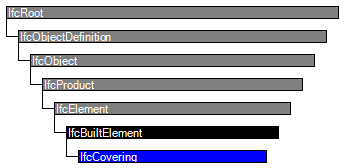
Attribute inheritance
| # | Attribute | Type | Cardinality | Description | G |
|---|---|---|---|---|---|
| IfcRoot | |||||
| 1 | GlobalId | IfcGloballyUniqueId | Assignment of a globally unique identifier within the entire software world. | X | |
| 2 | OwnerHistory | IfcOwnerHistory | ? |
Assignment of the information about the current ownership of that object, including owning actor, application, local identification and information captured about the recent changes of the object,
NOTE only the last modification in stored - either as addition, deletion or modification. IFC4 CHANGE The attribute has been changed to be OPTIONAL. | X |
| 3 | Name | IfcLabel | ? | Optional name for use by the participating software systems or users. For some subtypes of IfcRoot the insertion of the Name attribute may be required. This would be enforced by a where rule. | X |
| 4 | Description | IfcText | ? | Optional description, provided for exchanging informative comments. | X |
| IfcObjectDefinition | |||||
| HasAssignments | IfcRelAssigns @RelatedObjects | S[0:?] | Reference to the relationship objects, that assign (by an association relationship) other subtypes of IfcObject to this object instance. Examples are the association to products, processes, controls, resources or groups. | X | |
| Nests | IfcRelNests @RelatedObjects | S[0:1] | References to the decomposition relationship being a nesting. It determines that this object definition is a part within an ordered whole/part decomposition relationship. An object occurrence or type can only be part of a single decomposition (to allow hierarchical strutures only).
IFC4 CHANGE The inverse attribute datatype has been added and separated from Decomposes defined at IfcObjectDefinition. | X | |
| IsNestedBy | IfcRelNests @RelatingObject | S[0:?] | References to the decomposition relationship being a nesting. It determines that this object definition is the whole within an ordered whole/part decomposition relationship. An object or object type can be nested by several other objects (occurrences or types).
IFC4 CHANGE The inverse attribute datatype has been added and separated from IsDecomposedBy defined at IfcObjectDefinition. | X | |
| HasContext | IfcRelDeclares @RelatedDefinitions | S[0:1] | References to the context providing context information such as project unit or representation context. It should only be asserted for the uppermost non-spatial object.
IFC4 CHANGE The inverse attribute datatype has been added. | X | |
| IsDecomposedBy | IfcRelAggregates @RelatingObject | S[0:?] | References to the decomposition relationship being an aggregation. It determines that this object definition is whole within an unordered whole/part decomposition relationship. An object definitions can be aggregated by several other objects (occurrences or parts).
IFC4 CHANGE The inverse attribute datatype has been changed from the supertype IfcRelDecomposes to subtype IfcRelAggregates. | X | |
| Decomposes | IfcRelAggregates @RelatedObjects | S[0:1] | References to the decomposition relationship being an aggregation. It determines that this object definition is a part within an unordered whole/part decomposition relationship. An object definitions can only be part of a single decomposition (to allow hierarchical strutures only).
IFC4 CHANGE The inverse attribute datatype has been changed from the supertype IfcRelDecomposes to subtype IfcRelAggregates. | X | |
| HasAssociations | IfcRelAssociates @RelatedObjects | S[0:?] | Reference to the relationship objects, that associates external references or other resource definitions to the object.. Examples are the association to library, documentation or classification. | X | |
| IfcObject | |||||
| 5 | ObjectType | IfcLabel | ? | The type denotes a particular type that indicates the object further. The use has to be established at the level of instantiable subtypes. In particular it holds the user defined type, if the enumeration of the attribute PredefinedType is set to USERDEFINED. | X |
| IsDeclaredBy | IfcRelDefinesByObject @RelatedObjects | S[0:1] | Link to the relationship object pointing to the declaring object that provides the object definitions for this object occurrence. The declaring object has to be part of an object type decomposition. The associated IfcObject, or its subtypes, contains the specific information (as part of a type, or style, definition), that is common to all reflected instances of the declaring IfcObject, or its subtypes.
IFC4 CHANGE New inverse relationship, change made with upward compatibility for file based exchange. | X | |
| Declares | IfcRelDefinesByObject @RelatingObject | S[0:?] | Link to the relationship object pointing to the reflected object(s) that receives the object definitions. The reflected object has to be part of an object occurrence decomposition. The associated IfcObject, or its subtypes, provides the specific information (as part of a type, or style, definition), that is common to all reflected instances of the declaring IfcObject, or its subtypes.
IFC4 CHANGE New inverse relationship, change made with upward compatibility for file based exchange. | X | |
| IsTypedBy | IfcRelDefinesByType @RelatedObjects | S[0:1] | Set of relationships to the object type that provides the type definitions for this object occurrence. The then associated IfcTypeObject, or its subtypes, contains the specific information (or type, or style), that is common to all instances of IfcObject, or its subtypes, referring to the same type.
IFC4 CHANGE New inverse relationship, the link to IfcRelDefinesByType had previously be included in the inverse relationship IfcRelDefines. Change made with upward compatibility for file based exchange. | X | |
| IsDefinedBy | IfcRelDefinesByProperties @RelatedObjects | S[0:?] | Set of relationships to property set definitions attached to this object. Those statically or dynamically defined properties contain alphanumeric information content that further defines the object.
IFC4 CHANGE The data type has been changed from IfcRelDefines to IfcRelDefinesByProperties with upward compatibility for file based exchange. | X | |
| IfcProduct | |||||
| 6 | ObjectPlacement | IfcObjectPlacement | ? | Placement of the product in space, the placement can either be absolute (relative to the world coordinate system), relative (relative to the object placement of another product), or constraint (e.g. relative to grid axes). It is determined by the various subtypes of IfcObjectPlacement, which includes the axis placement information to determine the transformation for the object coordinate system. | X |
| 7 | Representation | IfcProductRepresentation | ? | Reference to the representations of the product, being either a representation (IfcProductRepresentation) or as a special case a shape representations (IfcProductDefinitionShape). The product definition shape provides for multiple geometric representations of the shape property of the object within the same object coordinate system, defined by the object placement. | X |
| ReferencedBy | IfcRelAssignsToProduct @RelatingProduct | S[0:?] | Reference to the IfcRelAssignsToProduct relationship, by which other products, processes, controls, resources or actors (as subtypes of IfcObjectDefinition) can be related to this product. | X | |
| PositionedRelativeTo | IfcRelPositions @RelatedProducts | S[0:1] | X | ||
| ReferencedInStructures | IfcRelReferencedInSpatialStructure @RelatedElements | S[0:?] | X | ||
| IfcElement | |||||
| 8 | Tag | IfcIdentifier | ? | The tag (or label) identifier at the particular instance of a product, e.g. the serial number, or the position number. It is the identifier at the occurrence level. | X |
| FillsVoids | IfcRelFillsElement @RelatedBuildingElement | S[0:1] | Reference to the IfcRelFillsElement Relationship that puts the element as a filling into the opening created within another element. | X | |
| ConnectedTo | IfcRelConnectsElements @RelatingElement | S[0:?] | Reference to the element connection relationship. The relationship then refers to the other element to which this element is connected to. | X | |
| IsInterferedByElements | IfcRelInterferesElements @RelatedElement | S[0:?] | Reference to the interference relationship to indicate the element that is interfered. The relationship, if provided, indicates that this element has an interference with one or many other elements.
NOTE There is no indication of precedence between IsInterferedByElements and InterferesElements. IFC4 CHANGE New inverse relationship. | X | |
| InterferesElements | IfcRelInterferesElements @RelatingElement | S[0:?] | Reference to the interference relationship to indicate the element that interferes. The relationship, if provided, indicates that this element has an interference with one or many other elements.
NOTE There is no indication of precedence between IsInterferedByElements and InterferesElements. IFC4 CHANGE New inverse relationship. | X | |
| HasProjections | IfcRelProjectsElement @RelatingElement | S[0:?] | Projection relationship that adds a feature (using a Boolean union) to the IfcBuildingElement. | X | |
| HasOpenings | IfcRelVoidsElement @RelatingBuildingElement | S[0:?] | Reference to the IfcRelVoidsElement relationship that creates an opening in an element. An element can incorporate zero-to-many openings. For each opening, that voids the element, a new relationship IfcRelVoidsElement is generated. | X | |
| IsConnectionRealization | IfcRelConnectsWithRealizingElements @RealizingElements | S[0:?] | Reference to the connection relationship with realizing element. The relationship, if provided, assigns this element as the realizing element to the connection, which provides the physical manifestation of the connection relationship. | X | |
| ProvidesBoundaries | IfcRelSpaceBoundary @RelatedBuildingElement | S[0:?] | Reference to space boundaries by virtue of the objectified relationship IfcRelSpaceBoundary. It defines the concept of an element bounding spaces. | X | |
| ConnectedFrom | IfcRelConnectsElements @RelatedElement | S[0:?] | Reference to the element connection relationship. The relationship then refers to the other element that is connected to this element. | X | |
| ContainedInStructure | IfcRelContainedInSpatialStructure @RelatedElements | S[0:1] | Containment relationship to the spatial structure element, to which the element is primarily associated. This containment relationship has to be hierachical, i.e. an element may only be assigned directly to zero or one spatial structure. | X | |
| HasCoverings | IfcRelCoversBldgElements @RelatingBuildingElement | S[0:?] | Reference to IfcCovering by virtue of the objectified relationship IfcRelCoversBldgElement. It defines the concept of an element having coverings associated. | X | |
| IfcBuiltElement | |||||
| IfcCovering | |||||
| 9 | PredefinedType | IfcCoveringTypeEnum | ? |
Predefined types to define the particular type of the covering. There may be property set definitions available for each predefined type.
NOTE The PredefinedType shall only be used, if no IfcCoveringType is assigned, providing its own IfcCoveringType.PredefinedType. | X |
| CoversSpaces | IfcRelCoversSpaces @RelatedCoverings | S[0:1] | Reference to the objectified relationship that handles the relationship of the covering to the covered space. | X | |
| CoversElements | IfcRelCoversBldgElements @RelatedCoverings | S[0:1] | Reference to the objectified relationship that handles the relationship of the covering to the covered element.
IFC4 CHANGE Renamed into CoversElements for consistency. | X | |
Definitions applying to General Usage
Concept usage
Object Typing
The Object Typing concept applies to this entity.
Property Sets for Objects
The Property Sets for Objects concept template applies to this entity as shown in Table 123.
| ||||||||||||||||||||||||||||||||||||||||||||||||||||
Table 123 — IfcCovering Property Sets for Objects |
Quantity Sets
The Quantity Sets concept template applies to this entity as shown in Table 124.
| ||||
Table 124 — IfcCovering Quantity Sets |
Spatial Containment
The Spatial Containment concept template applies to this entity as shown in Table 125.
| ||
Table 125 — IfcCovering Spatial Containment |
The IfcCovering has a containment relationship within the hierarchical spatial structure.
- The IfcCovering is places within the project spatial hierarchy using the objectified relationship IfcRelContainedInSpatialStructure, referring to it by its inverse attribute SELF\IfcElement.ContainedInStructure. Subtypes of IfcSpatialStructureElement are valid spatial containers, with IfcSpace being the default container.
Material Layer Set Usage
The Material Layer Set Usage concept template applies to this entity as shown in Table 126.
| ||||||||
Table 126 — IfcCovering Material Layer Set Usage |
Coverings for surfaces (CEILING, FLOORING, CLADDING, CEILING, ROOFING) may have materials defined according to layers.
Material Profile Set Usage
The Material Profile Set Usage concept template applies to this entity as shown in Table 127.
| ||||
Table 127 — IfcCovering Material Profile Set Usage |
Coverings for edges (MOLDING, SKIRTINGBOARD) may have materials defined according to profiles.
Surface Geometry
The Surface Geometry concept applies to this entity.
The following additional constraints apply to the 'GeometricSet' representation of IfcCovering:
- for planar base surfaces - bounded surface representation
- for cylindrical base surfaces - swept surface representation
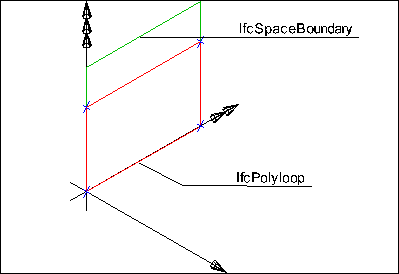 |
EXAMPLE Figure 213 illustrates a planar surface representation where the area of IfcCovering is given by an IfcPolyLoop for planar base surfaces (here provided by the IfcRelSpaceBoundary). The implicit planar surface of the IfcPolyLoop shall be identical with the planar surface defined by the IfcRelSpaceBoundary. |
|
Figure 213 — Covering surface planar |
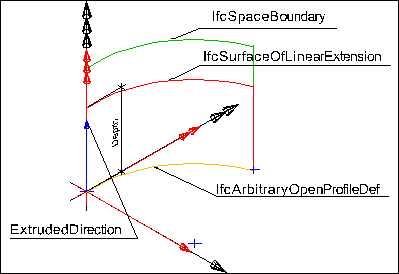 |
EXAMPLE Figure 214 illustrates a cylindrical surface representation where the area of the IfcCovering is given by an IfcSurfaceOfLinearExtrusion for cylindrical base surfaces (here given by the IfcRelSpaceBoundary, such as caused by a round wall).
|
|
Figure 214 — Covering surface cylindrical |
Body SweptSolid Geometry
The Body SweptSolid Geometry concept applies to this entity.
The following additional constraints apply to the 'SweptSolid' representation of IfcCovering:
- for planar base surfaces - swept area representation
- for cylindrical base surfaces - swept area representation
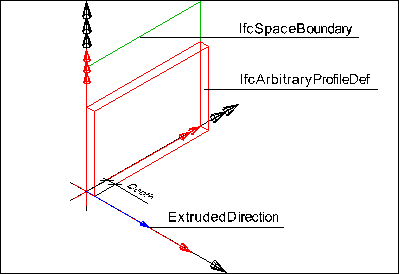 |
EXAMPLE Figure 215 illustrates a body representation where the volume of IfcCovering is given by an IfcExtrudedAreaSolid for planar base surfaces (here given by the IfcRelSpaceBoundary). The extruded area (IfcArbitraryClosedProfileDef) shall be coplanar to the surface defined by the IfcRelSpaceBoundary. |
|
Figure 215 — Covering body planar |
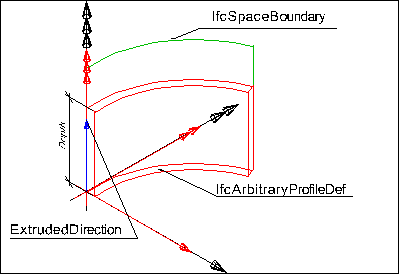 |
EXAMPLE Figure 216 illustrates a body representation where the volume of the IfcCovering is given by an IfcExtrudedAreaSolid for cylindrical base surfaces (here given by the IfcRelSpaceBoundary - such as caused by a round wall).
|
|
Figure 216 — Covering body circular |
mvdXML Specification
<?xml version="1.0" encoding="utf-8"?>
<ConceptRoot xmlns:xsi="http://www.w3.org/2001/XMLSchema-instance" uuid="71f56697-4f86-45c6-a960-7dbf2c5424a7" name="IfcCovering" applicableRootEntity="IfcCovering">
<Applicability>
<Template ref="d24c3034-cab6-4612-9eb8-9f814dd9a3d4" />
<TemplateRules operator="and">
</TemplateRules>
</Applicability>
<Concepts>
<Concept uuid="e2c62edc-7fd0-41e4-9e89-5c348b65492f" name="Object Typing">
<Template ref="35a2e10e-20df-40f4-ab2f-dacf0a6744f4" />
</Concept>
<Concept uuid="097c3f91-ba3f-4c90-9503-4873e56e7587" name="Property Sets for Objects">
<Template ref="f74255a6-0c0e-4f31-84ad-24981db62461" />
<TemplateRules operator="and">
<TemplateRule Parameters="PsetName[Value]='Pset_CoveringCommon'" />
</TemplateRules>
</Concept>
<Concept uuid="397523b1-8cc5-4172-aeac-d1d73f8ab001" name="Quantity Sets">
<Template ref="6652398e-6579-4460-8cb4-26295acfacc7" />
<TemplateRules operator="and">
<TemplateRule Parameters="QsetName[Value]='Qto_CoveringBaseQuantities'" />
</TemplateRules>
</Concept>
<Concept uuid="c24fd65c-3172-428f-ae20-07886b19ecae" name="Spatial Containment">
<Template ref="d9a3f822-0014-4bc2-8d94-9d9067759045" />
<TemplateRules operator="and">
<TemplateRule Parameters="RelatingStructure[Type]='IfcSpace'" />
</TemplateRules>
</Concept>
<Concept uuid="1317ca91-462b-4bfe-a951-8b1e0cbd0aa5" name="Material Layer Set Usage">
<Template ref="6d5fb86f-3f2d-49fb-9528-077855ddcc47" />
<TemplateRules operator="and">
<TemplateRule Description="Optional front-facing material of layer-based coverings such as drywall paper." Parameters="Name[Value]='Front'" />
<TemplateRule Description="The solid material of layer-based coverings such as drywall gypsum." Parameters="Name[Value]='Fill'" />
<TemplateRule Description="Optional back-facing material of layer-based coverings such as drywall paper." Parameters="Name[Value]='Back'" />
</TemplateRules>
</Concept>
<Concept uuid="9e0bc382-529e-40c9-838f-bf81ca989828" name="Material Profile Set Usage">
<Template ref="6aa01429-b566-4b36-875a-3162088a9831" />
<TemplateRules operator="and">
<TemplateRule Description="Profile of trim such as crown molding or base molding." Parameters="Name[Value]='Trim'" />
</TemplateRules>
</Concept>
<Concept uuid="e9e34f36-1a74-4ae4-aa59-a4208cfdce63" name="Surface Geometry">
<Template ref="2e99de70-fb73-478f-9bca-4fedfdeb4ea5" />
</Concept>
<Concept uuid="57fa00e6-30ca-4650-8686-9f8fc8fbb90b" name="Body SweptSolid Geometry">
<Template ref="cb7c18fa-cf83-4db1-be1b-c013ba4ed672" />
</Concept>
</Concepts>
</ConceptRoot>
Concept inheritance
Formal representations
XML Specification
<xs:element name="IfcCovering" type="ifc:IfcCovering" substitutionGroup="ifc:IfcBuiltElement" nillable="true"/>
<xs:complexType name="IfcCovering">
<xs:complexContent>
<xs:extension base="ifc:IfcBuiltElement">
<xs:attribute name="PredefinedType" type="ifc:IfcCoveringTypeEnum" use="optional"/>
</xs:extension>
</xs:complexContent>
</xs:complexType>
EXPRESS Specification
ENTITY IfcCovering
SUBTYPE OF (IfcBuiltElement);
PredefinedType : OPTIONAL IfcCoveringTypeEnum;
INVERSE
CoversSpaces : SET [0:1] OF IfcRelCoversSpaces FOR RelatedCoverings;
CoversElements : SET [0:1] OF IfcRelCoversBldgElements FOR RelatedCoverings;
WHERE
CorrectPredefinedType : NOT(EXISTS(PredefinedType)) OR
(PredefinedType <> IfcCoveringTypeEnum.USERDEFINED) OR
((PredefinedType = IfcCoveringTypeEnum.USERDEFINED) AND EXISTS (SELF\IfcObject.ObjectType));
CorrectTypeAssigned : (SIZEOF(IsTypedBy) = 0) OR
('IFCSHAREDBLDGELEMENTS.IfcCoveringType' IN TYPEOF(SELF\IfcObject.IsTypedBy[1].RelatingType));
END_ENTITY;
 References: IfcRelCoversBldgElements
IfcRelCoversSpaces
References: IfcRelCoversBldgElements
IfcRelCoversSpaces

 Instance diagram
Instance diagram Link to this page
Link to this page